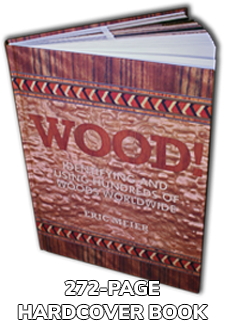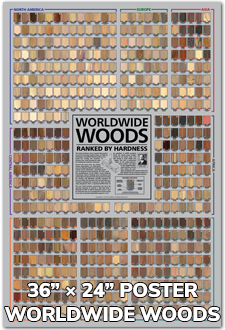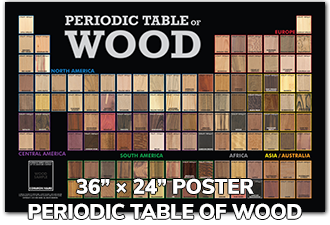by Eric Meier
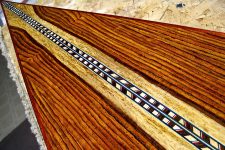
Let’s take a look at all the different types of rosewoods of the world, genuine or otherwise. What constitutes a true “rosewood,” which species might be close enough, which are mostly aspiration in their naming, and how do we tell them all apart.
A Rose(wood) by any other name…
Historically, the most relevant name for rosewood is jacarandá. This was the original name that Portuguese traders adopted from the native Tupi–Guarani language (this same language group is the source of a handful of other common words like jaguar, piranha, and tapioca). It’s believed that jacarandá simply means “fragrant”[1]Ajuntament de Barcelona. (n.d.). Jacaranda mimosifolia. Medi Ambient. Retrieved March 27, 2025, from https://web.archive.org/web/20160715162321/https://mediambient.itineraris.bcn.cat/en/node/259/365—though the word origins of these languages are still not clearly understood.[2]Balée, W., & Badie, M. C. (2009). The meaning of “tree” in two different Tupí-Guaraní languages from two different Neotropical forests. Amazônica-Revista de Antropologia, 1(1). And while today the common name usually refers instead to the cosmopolitan ornamental tree Jacaranda mimosifolia (the blue jacaranda), the early Portuguese traders tended to use the name in a much narrower way, usually applying it to the lucrative scented lumber that could be harvested from Brazil’s forests.
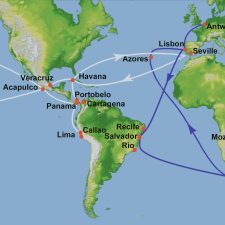
The Portuguese used the jacaranda appellation and commonly paired it with the port where it was most commonly exported—a common pattern of lumber naming that continues to this day. Of these, it appears that the lumber coming out of Salvador, a port in the state of Bahia, Brazil, was the most significant, and went by the name Jacarandá-da-Bahia.[3]Ribeiro, S. P. (2020, January 21). The importance of jacaranda wood in Portuguese furniture. Séculos Passados. In our modern context and understanding, this lumber was the very first species that could properly be called rosewood, and botanically refers to Dalbergia nigra, Brazilian rosewood.
But it’s important to note that although this appears to be the most prevalent of the jacarandas being traded in these early times (16th-18th centuries), it was not the only one—and more than that, Dalbergia species were not even the only species being traded as rosewood either.
Early Portuguese Jacaranda species
Jacarandá-da-Bahia, Dalbergia nigra
Jacarandá-violeta, Dalbergia cearensis
Jacarandá do Pará, Dalbergia spruceana
Jacarandá-do-cerrado, Machaerium villosum
Jacarandá preto, sometimes refers to Zollernia paranese
Separating Dalbergia Species
As with so many other genera, there’s no universal rule that will distinguish Dalbergia rosewoods from one another. In most instances, a number of physical and anatomical features should be considered.
Appearance: Some species can be separated reasonably well based on appearance alone, such as African blackwood (D. melanoxylon), bois de rose (D. maritima), and tulipwood (D. decipularis). A few may have characteristic “spider-webbing” similar to ziricote (Cordia dodecandra), such as Brazilian or Madagascar rosewood (D. nigra and D. baronii, respectively).
Weight: Dried wood can vary by ±10% or more from its average or expected density, so in many cases weight may not be conclusive and can overlap several other lookalike species. African blackwood (D. melanoxylon) and kingwood (D. cearensis) are among the heaviest species, while sissoo (D. sissoo) and Panama rosewood (D. tucurensis) are among the lightest.
Scent: Most species have a more or less distinct, rose-like scent when being worked, though Panama rosewood (D. tucurensis) is a scentless exception. In most instances, species that lack this odor can be separated from true Dalbergia species.
Endgrain: Most species are diffuse-porous, while a few are semi-ring porous, such as Honduras rosewood (D. stevensonii). A key element in distinguishing Brazilian rosewood (D. nigra) from East Indian rosewood (D. latifolia) is pore frequency: Brazilian rosewood will have very few pores per square millimeter (less than five), while East Indian rosewood will have approximately twice the amount of pores (four to eight) in a given area.
Water Extract Fluorescence: This diagnostic combines two different techniques for identifying wood: the heartwood fluorescence test (described on page 20), and the water extractives leachability test (described on page 23). Wood shavings are mixed with water in a vial or small container, and the water itself is checked for fluorescence after a few minutes. Extractives of nearly all Dalbergia rosewoods will glow a pale blue/green color under the blacklight, while Brazilian rosewood (D. nigra) will not fluoresce.
References[+]
| ↑1 | Ajuntament de Barcelona. (n.d.). Jacaranda mimosifolia. Medi Ambient. Retrieved March 27, 2025, from https://web.archive.org/web/20160715162321/https://mediambient.itineraris.bcn.cat/en/node/259/365 |
|---|---|
| ↑2 | Balée, W., & Badie, M. C. (2009). The meaning of “tree” in two different Tupí-Guaraní languages from two different Neotropical forests. Amazônica-Revista de Antropologia, 1(1). |
| ↑3 | Ribeiro, S. P. (2020, January 21). The importance of jacaranda wood in Portuguese furniture. Séculos Passados. |

